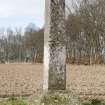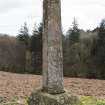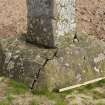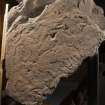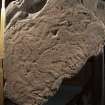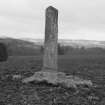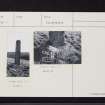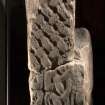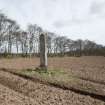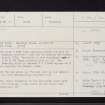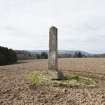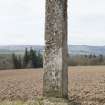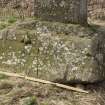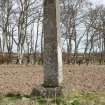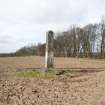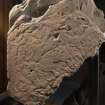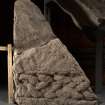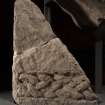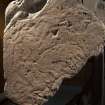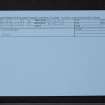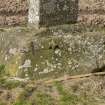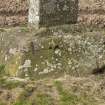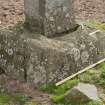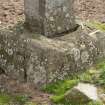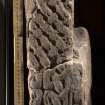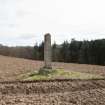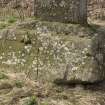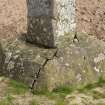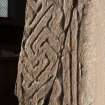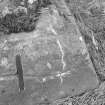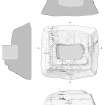Invermay, Cross
Cross (Period Unassigned)
Site Name Invermay, Cross
Classification Cross (Period Unassigned)
Canmore ID 26605
Site Number NO01NE 8
NGR NO 0598 1664
Datum OSGB36 - NGR
Permalink http://canmore.org.uk/site/26605
- Council Perth And Kinross
- Parish Forteviot
- Former Region Tayside
- Former District Perth And Kinross
- Former County Perthshire
Invermay 1, Perthshire, cross-shaft fragment
Measurements: H 0.40m, W 0.28m, D 0.13m
Stone type: sandstone
Place of discovery: NO 0598 1664
Present location: at Forteviot parish church.
Evidence for discovery: the cross had been destroyed shortly before 1770 and its fragments were described in 1796 in the Statistical Account. A plain stone was erected in the original base around 1840, and in 1891 Allen was shown the base, together with three fragments of the cross on a nearby clearance cairn. The fragments were later taken to Forteviot Church.
Present condition: weathered and broken, retaining part of the narrow face.
Description
Face A of this fragment is entirely worn or damaged, but part of face D survives, carved in low relief with median-incised four-cord interlace with a cruciform break in the pattern.
Date range: ninth century.
Primary references: Statistical Account, vol 20, 125; ECMS pt 3, 327-8; Aitchison 2006, 125-131; Hall 2011, 148-9.
Desk-based information compiled by A Ritchie 2018
Invermay 2, Perthshire, cross fragments
Measurements: H 0.72m, W 0.53m, D 0.29m
Stone type: sandstone
Place of discovery: NO 0598 1664
Present location: at Forteviot parish church.
Evidence for discovery: the cross had been destroyed shortly before 1770 and its fragments were described in 1796 in the Statistical Account. A plain stone was erected in the original base around 1840, and in 1891 Allen was shown the base, together with three fragments of the cross on a nearby clearance cairn. The fragments were later taken to Forteviot Church, and at some point between 1978 and 1997 fragment 1b was re-used in the retaining wall on the east side of the Water of May and re-discovered in the latter year.
Present condition: broken and damaged, with parts of two carved faces surviving.
Description
These two fragments are conjoining and show that the shaft must have been about 0.30m in thickness and more than 0.57m in width. Parts of faces B and C survive, both edged by flat-band mouldings with inner roll mouldings. Face B shows parts of four panels of ornament: just a corner of the uppermost panel, above a narrow horizontal panel of key pattern, above a rectangular panel of diagonal key pattern, and finally part of a panel of median-incised triangular interlace. Face C bears part of a larger figural panel in which a human figure brandishing a club strides behind a docile-looking boar or pig. The animal is behind an upright strip, perhaps the trunk of a small tree.
Date range: ninth century.
Primary references: Statistical Account, vol 20, 125; ECMS pt 3, 327-8, nos 1a and 1b; Simpson 1997; Aitchison 2006, 115, 118-19 (Forteviot 7), 125-31 (Invermay 1a); Hall 2011, 148-9.
Desk-based information compiled by A Ritchie 2018
Invermay 3, Perthshire, cross fragment
Measurements: H 0.61m, W 0.52m, D 0.17m
Stone type: sandstone
Place of discovery: NO 0598 1664
Present location: at Forteviot parish church.
Evidence for discovery: the cross had been destroyed shortly before 1770 and its fragments were described in 1796 in the Statistical Account. A plain stone was erected in the original base around 1840, and in 1891 Allen was shown the base, together with three fragments of the cross on a nearby clearance cairn. The fragments were later taken to Forteviot Church. This particular fragment was not seen by Romilly Allen in 1891 and was presumably taken to Forteviot for safe keeping at a later date (formerly known as Forteviot 8).
Present condition: one short section of edge is intact (faces D/A), but the other edges are broken, and face C has flaked away.
Description
This fragment appears to belong to the basal portion of the cross, carved in low relief. Face A has a wide plain flat-band border and parts of two panels, separated by a roll moulding. The lower panel is filled with three-cord interlace, but any ornament in the upper panel has worn away. Face D has a narrow flat-band border, within which is a roll moulding outlining a panel of four-cord interlace, using median-incised cord and forming a cruciform break in the pattern (Invermay 1 is part of the same narrow face). There is part of the basal tenon surviving.
Date range: ninth century.
Primary references: Statistical Account, vol 20, 125; Aitchison 2006, 118-19 (Forteviot no 8); Hall 2011, 146-9.
desk-based information cmpiled by A Ritchie 2018
Invermay 4, Perthshire, cross base
Measurements: L 1.34m tapering upwards to 1.06m, W 1.14m tapering up to 0.90m, H 0.64m
Stone type: sandstone
Place of discovery: NO 0598 1664
Present location: in situ in a field north of Invermay House and south-east of Forteviot.
Evidence for discovery: the cross had been destroyed shortly before 1770 and its fragments were described in 1796 in the Statistical Account. A plain stone was erected in the original base around 1840, and in 1891 Allen was shown the base, together with three fragments of the cross on a nearby clearance cairn. The fragments were later taken to Forteviot Church.
Present condition: weathered and plough-damaged, its fractures held together by iron clamps.
Description
Trapezoidal in form, this large block of stone has been carefully shaped and the central socket is surrounded by a projecting lip. The socket measures about 0.30m by 0.50m.
Date range: ninth century.
References: Statistical Account, vol 20, 125; ECMS pt 3, 327; Aitchison 2006, 126-7; Hall 2011, 149.
Desk-based information compiled by A Ritchie 2018
NO01NE 8 0598 1664
See also NO01NE 10.00.
(NO 0598 1664) Standing Stone, on Site of Sculptured Stone (NR)
OS 6" map, (1959)
Stone on remains of [NAT] Cross [NR]
OS 1:10,000 map, 1987.
A large stone 9 feet high standing inside the wall of Invermay demesne, erected c 1840 (ONB 1860) to replace one broken not long before 1770. Fragments in the churchyard at Forteviot (NO01NE 10) are probably part of it. The original pedestal which is between 2 and 3 feet square still stands and supports the modern stone.
In 1796 the old cross lay "broken over at the pedestal on which are many emblematical figures" (Statistical Account {OSA} 1796).
In 1891, three fragments of the destroyed cross were lying in the firwood, 1/4 mile north of the cross site (Long Plantation) (Allen and Anderson 1903).
OSA 1796; Name Book 1860; J Stuart 1856; J R Allen and J Anderson 1903.
There is nothing known locally of a connection between the stones at Forteviot Church (NO01NE 10.00) and this site. No trace could be found of the fragments in Long Plantation.
Visited by OS (J T T) 5 November 1965.
The three fragments of the destroyed cross are now in the porch of the church at Forteviot.
Information contained in letter from J Close-Brooks, National Museum of Antiquities of Scotland (NMAS) to OS, 20 April 1978.





































